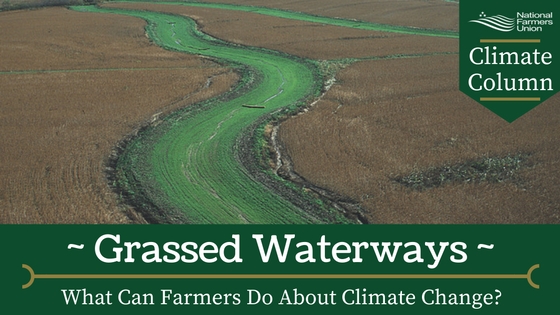 By Thomas Driscoll, Director of Conservation Policy and Education
By Thomas Driscoll, Director of Conservation Policy and Education
The Climate Column has discussed several practices to avoid soil erosion, such as no-till and cover crops, that farmers can use to mitigate and adapt to climate change. Preventing erosion is critical to building healthy soils that store carbon from the atmosphere, mitigating the negative impacts of climate change. Working against erosion is also an important adaptive practice, since many areas of the United States will be subject to more frequent and intense extreme precipitation events. Another way farmers can prevent erosion and increase climate resilience is the use of grassed waterways, especially in areas that are prone to the formation of gullies.
Grassed waterways are grassy or vegetated channels through which accumulated precipitation passes. The vegetation serves to slow runoff, decreasing its capacity for erosion. Using a grassed waterway involves establishing the capacity for conveying water the producer needs, determining the dimensions needed to achieve such conveyance, selecting and planting vegetation with the proper characteristics to stabilize the waterway, and maintaining the waterway, including vegetation maintenance and protecting the waterway at times of concentrated flow.
The U.S. Department of Agriculture (USDA) Natural Resource Conservation Service (NRCS) notes important co-benefits associated with grassed waterways in its Conservation Practice Standard. The practice also takes nutrients and pollutants out of runoff, improving water quality in the area. But without even considering climate and water quality benefits, producers know that gullies form in ground that is difficult to farm efficiently or conveniently, and that gullies are hard on machinery and equipment. Producers may want to consider whether a grassed waterway might be worth it to avoid the trouble.
Do you have a grassed waterway on your farm? Have you ever considered putting one in? Why or why not? Please share your thoughts and impressions on this practice in the comments section!
Like what you’ve read? Check out our Climate Leaders home page, join the conversation in the NFU Climate Leaders Facebook Group, and keep up-to-date with NFU climate action by signing up for the mailing list.